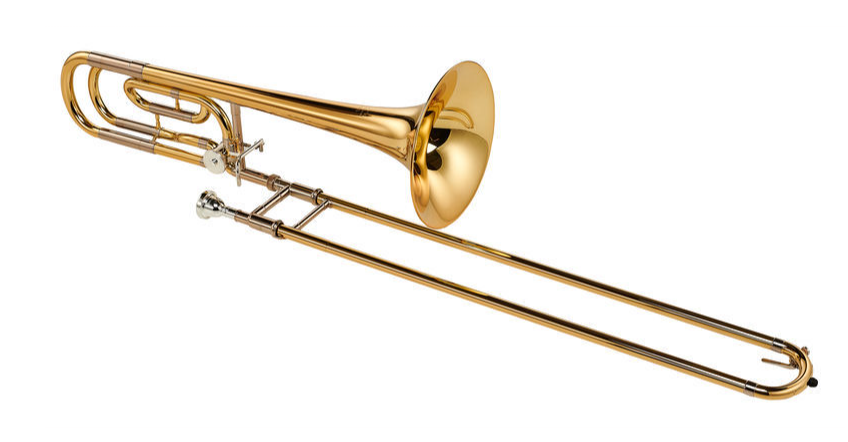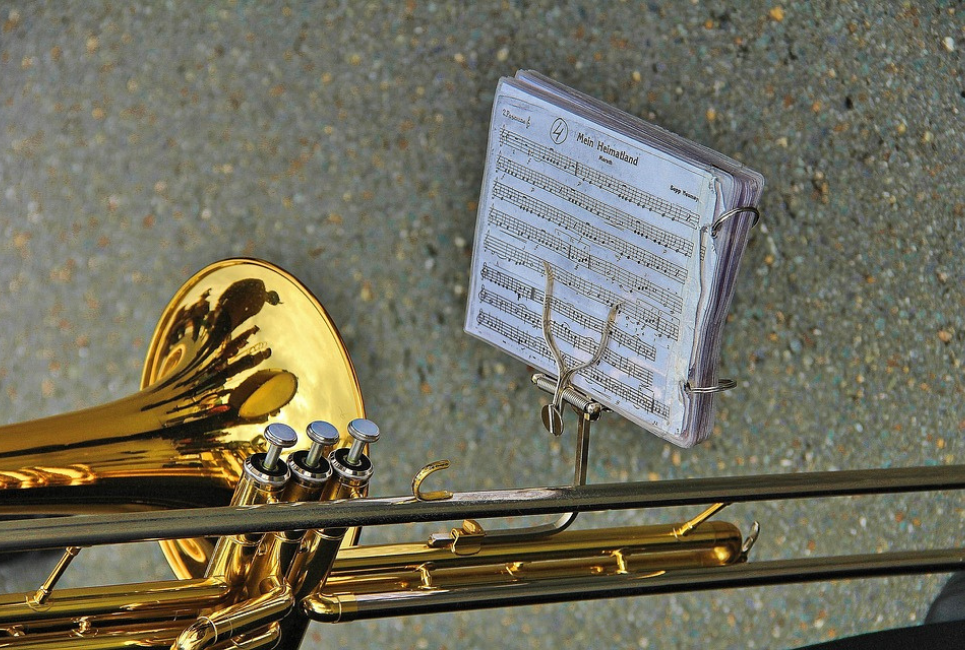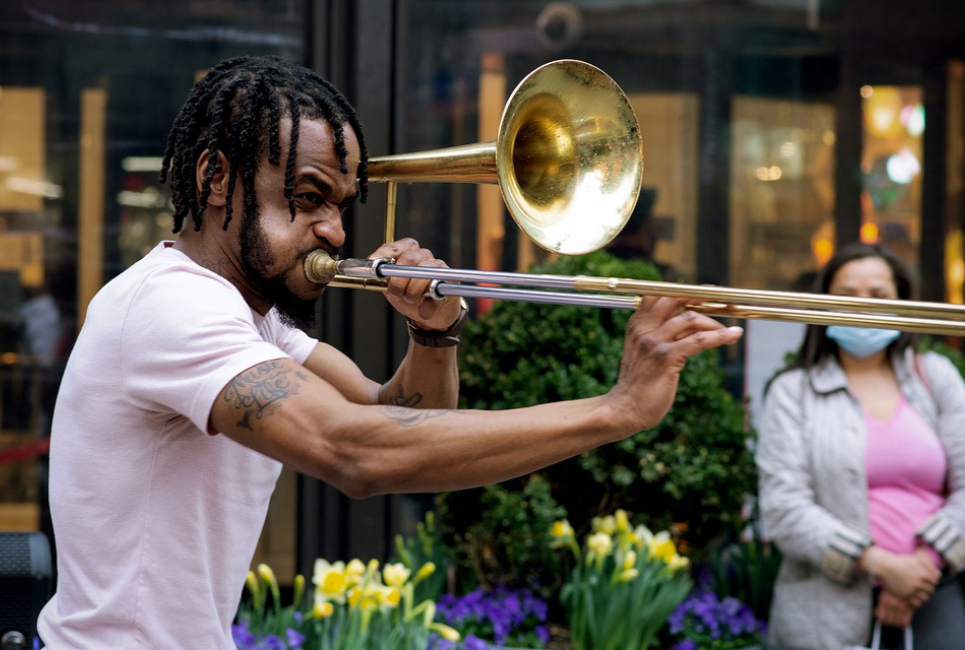- Euphonium vs Baritone Compared - September 5, 2022
- How to Find the Best Contra Alto Clarinet - August 20, 2022
- Mellophone vs Trumpet Compared - August 6, 2022
Trombones are amazing instruments, but they don’t come cheap. When you are shopping for a new trombone, you want to make sure you are getting the best instrument you can afford. And when you want reliability and quality in a musical instrument, few manufacturers top the best Yamaha trombone options.
Yamaha has branched out since Torakusa Yamaha opened the Nippon Gakki (Japan Musical Instrument) Company in 1887 to build reed organs. Today you can find Yamaha instruments in orchestras, jazz clubs, conservatories, and student programs worldwide. Musicians of all genres praise Yamaha trombones for their durability, reliability, and excellent tone.
How I Chose the Best Yamaha Trombone Options

At whatever performance level, musicians need their instruments to be reliable, comfortable, and playable. Yamaha trombones meet those requirements. Students, professionals, and amateur musicians can count on their Yamaha to deliver great sound.
I tried to explain the difference between beginning, intermediate, and professional trombones. An untrained eye might have difficulty distinguishing between Yamaha’s range of trombones. A beginning performer would likely produce very similar sounds from each. But the more expensive models offer advantages that skilled trombonists will recognize immediately.
At the professional level, I distinguished between jazz and orchestral trombonists. However, many professional trombonists have a foot in both worlds, jazz and classical music place different demands on the musician. Professionals in either genre would be able to use either trombone but would also seek out the instrument which best met their needs.
As we all know, music is not the most lucrative of careers. I have tried to steer prospective trombonists toward models that will best fit their needs. Yamaha instruments are not inexpensive, but neither are they unreasonably priced. And because Yamaha instruments are so well-known, they hold their value well on the used market should you decide to upgrade.
A trombone, like any instrument, is an investment in your musical future. Your old Yamaha will serve you well now, and you will be able to recoup a large chunk of the price later toward your new Yamaha.
Best Yamaha Trombone for Beginners: YSL-354

In a world where you can buy “student trombones” for under $150, spending nearly $1,500 on a YSL-354 may seem extravagant. But those cheap trombones often come with squeaky, ill-fitting slides that make playing difficult. A talented trombonist might be able to get a decent sound out of these bargain instruments, but most beginners will give up in frustration.
The YSL-354 will not stand in the way of a beginner’s music-making. The slide will work properly, and the instrument will reward good technique with great sound. The 354 has a solid, beefy tone in the low and middle-end. The closely fitted slides will hold a note without slipping but may require some break-in time and regular applications of slide cream.
College and professional marching bands regularly use YSL-354s for their trombone section. 354s are durable enough to withstand the rigors of marching, loud enough to fill a stadium with music, and reliable enough to avoid sour notes on national television. Trombone students practicing on a 354 will be in good company.
If you are the parent of a student who has shown little interest in practicing their cheap trombone, I suggest you rent a YSL-354 from a local music shop. The additional ease of playing and superior sound may well spark greater interest, and many music shops will let you apply some or all the rental cost to purchase.
The Yamaha YSL-354 Standard Trombone was designed to make it easier for beginning students to sound good as soon as possible.
Pros
- Excellent weight distribution makes YSL-354 easy to hold
- Best-sounding entry-level trombone on the market
- Rugged bell and crook withstand band trips and accidents
Cons
- Less free-blowing than some trombones and may be more difficult to hit high notes
YSL-354 Specs
- Key: B♭
- Bell Material: Yellow brass
- Bell Diameter: 204.4mm(8”)
- Bore Size: 12.7mm (0.5″)
- Outer Slide Material: Yellow brass
- Inner Slide Material: Nickel Silver
- Finish: Gold lacquer (also available in silver-plated)
- Mouthpiece: SL-48S
- Case: Included
Best Intermediate Yamaha Trombone: YSL-445G

The Yamaha YSL-445G has a slightly larger bore than the YSL-354. A wider bore demands more air from the performer, but it has a richer, more ringing tone. Like the 354, the 445G holds up to the demands of touring.
When Yamaha releases a new line of Pro trombones, it often moves the former Proline to intermediate status. The 445G uses many of the innovations from Yamaha’s earlier and much-loved 645 trombones, though it replaces some of the 645’s nickel silver tubing with less expensive brass.
The 445G has inner slide stockings that help keep the slide aligned even in the challenging 6th and 7th positions. If you have problems hitting the lowest notes with your 345, the 445G will make things easier for you. And the 445 G’s balance weight helps you hold your trombone comfortably.
Trombonists who focus on orchestral music might prefer the YSL-447G. It is identical to the 445G save for an even wider 0.547″ bore. This places added demands on your lungs but gives that more rounded and less penetrating sound favored by most classical audiences.
Key of Bb. .525" bore, 8-1/2" gold brass bell, chromeplated nickel silver inner slide, yellow brass outer slide, slide lock, lacquer finish. Includes case, mouthpiece, and slide cream.
Pros
- Richer tone and smoother action than the YSL-445G
- Many trombonists believe Yamaha’s intermediate line offers the best price/value ratio
- Built to handle touring, performance, and practice demands
Cons
- No F attachment
YSL-445G/447G Specs
- Key: B♭
- Bell Material: Yellow brass; One-piece [445G];Gold brass; One-piece [447G]
- Bell Diameter: 214.4 mm (8 1/2″)
- Shank: Medium
- Leadpipe: Yellow Brass; Fixed
- Body Material: Yellow Brass
- Weight: Standard
- Bore Size: 13.34 mm (0.525”) [445G]; 13.89 mm (0.547”) [447G]
- Outer Slide Material: Yellow brass
- Inner Slide Material: Chrome-plated nickel silver; Drawn
- Finish: Clear Lacquer
- Mouthpiece: 48 [445G], L48 [447G]
- Features: Balance weight
Best Jazz Yamaha Trombone: YSL-891Z

Yamaha’s YSL-891Z trombone was made for jazz. Yamaha employed professional jazz trombonists Wycliffe Gordon and Andy Martin as consultants on the 891Z’s design. The 891Z’s 0.508″ bore gives it a more penetrating and focused sound that stands out on jazz solos. And the hand-hammered one-piece bell produces more pure resonances and a superior tone.
Most trombones come with their lead pipes — the pipe connecting the trombone mouthpiece to the instrument — soldered in place. The YSL-891Z comes with two interchangeable leadpipes. The longer NY leadpipe was developed with Gordon, while Martin helped design the LA leadpipe.
A short, broad leadpipe gives a more open sound. A long, tapered leadpipe provides more feedback pressure: some trombonists find this gives them better control over tone and timbre. The 891Z lets you decide which leadpipe works for you. And because the YSL-891Z is lighter in weight, you’ll find it a joy to play during concerts and practice.
Professionals praise the YSL-891Z for its versatility. The 891Z can play a warm, romantic piece that tugs at your heartstrings, then lay down some grooves that will get your toes tapping. When you’re playing in a wedding band or on call in a studio, you want an instrument that can do it all. And if you’re a jazz trombonist, the YSL-891Z will do it all for you.
Pros
- Interchangeable leadpipes
- Designed by professional jazz trombonists
- The lighter weight makes playing long hours more comfortable
Cons
- No F attachment
YSL-891Z Specs
- Key: B♭
- Bell Material: Yellow Brass; One-piece; Hand Hammered
- Bell Diameter: 204.4mm (8″)
- Shank: Medium
- Leadpipe: Two interchangeable: NY (longer) and LA (shorter)
- Body Material: Yellow Brass
- Weight: Light
- Bore Size: 12.9 mm (0.508″)
- Outer Slide Material: Yellow brass; Drawn
- Inner Slide Material: Chrome-plated nickel silver; Drawn
- Finish: Clear Epoxy Lacquer
- Mouthpiece: 45C2
Best Orchestral Yamaha Trombone: YSL-882 Xeno

If you want to play with an orchestra, you will need a trombone with an F-attachment. The F-attachment gives you an extra fourth on the bottom end without changing the sound or key of your instrument. Those lowest notes often appear in symphonic music, and you will be competing at auditions with people using B♭/F trombones.
Professional musicians have strong opinions about what they want in their instruments. Yamaha gives professional tubists several choices in their top-of-the-line B♭/F trombone selection.
The YSL-882 has a traditional closed wrap F-attachment which produces a more ringing, French horn-like sound. While some trombonists feel the open wrap offers better airflow and is easier to play, closed wrap B♭/F trombones take up less orchestra pit space and are less prone to dents than open wrap B♭/F trombones.
The YSL-882O has an open wrap design which provides a smooth response and a clear, steady tone on difficult notes. Pittsburgh Symphony Principal Trombonist Peter Sullivan helped Yamaha design the 882O. The YSL-882O has a narrow slide which makes fast passages easier.
The YSL-882OR was designed with the assistance of Larry Zalkind, professor of trombone at the Eastman School of Music. The 882OR’s reversed B♭ and F tuning slides allow for less restricted airflow, and the wider slide gives it a darker, romantic tone well-suited for symphonic works.
Yamaha’s Xeno line of trombones features hand-hammered bells and thicker brass, giving them a rich, resonant sound. The 882 Xenos can declaim through Mahler and mourn through Mozart. 882s are found in symphonies, conservatories, and ensembles worldwide. If you are serious about your career as a trombonist, the 882OR will give you a lifetime of service.
Custom Z Trombone; .484" - .490" dual bore; Z1 and Z2 leadpipes; 7 1/2" yellow-brass bell; SLC-891Z case; SL46C2 mouthpiece.
Pros
- A removable leadpiece lets you switch other mouthpieces
- Noted for its sensitivity to embouchure and accuracy
- Played by trombonists in major symphonies worldwide
Cons
- At 17 pounds (8kg), this is a heavy trombone
- Open wrap F-attachments take up a lot of space
YSL-882 Xeno Specs
- Key: B♭/F
- Bell Material: Yellow Brass; One-piece; Hand Hammered. (Also available in Gold Brass)
- Bell Diameter: 220 mm (8 2/3″)
- Bore Size: 13.89 mm (0.547″)
- Outer Slide Material: Yellow brass; Drawn
- Inner Slide Material: Chrome-plated nickel silver; Drawn
- Finish: Clear Epoxy Lacquer
- Mouthpiece: SL-51C4L
FAQs
Answer: Some people claim that the trombone is the easiest instrument of the brass family to learn because the slide, not valves, controls the tones. But because the slide also allows intermediate tones, a trombone player must have an excellent ear for pitch to avoid sour notes.
Others note that the trombone can be difficult for people with shorter arms. The lowest notes on a trombone require a long reach. An F valve attachment can help, as can a smaller trombone like the Yamaha YSL-350C, which includes a B♭/C rotor that allows players to hit lower notes without stretching so far.
Learning the proper embouchure takes time, and because the trombone is a bigger instrument, it requires more wind than a cornet or trumpet. The trombone is also large and can be heavy, which may take some getting used to. And some advanced brass techniques like multiphonics and flutter-tonguing can be more complicated when you are also moving your arm vigorously.
Answer: While the trombone’s natural series of harmonics is B♭like a clarinet and a trumpet, the trombone is not a transposing instrument. A written C on a trombone score is played at a concert pitch C.
When a trumpeter or clarinetist plays a C from a written score, they are actually playing a B♭. The composer makes allowances for this by transposing the clarinet line up a whole step. If the piece is in D minor, the composer will write the clarinet line in E minor.
Trumpets, clarinets, and other brass and woodwinds come in different keys. B♭ and E♭clarinets have identical fingerings, but their “C” fingering will produce either a B♭(a step lower) or an E♭(a minor third higher). By specifying the key and transposing the music to fit the pitch requirements, a composer could make sure that players used appropriate instruments.
Transposing also makes things easier for musicians. The valve fingerings on many brass instruments are identical: trumpeters can also, with transposition, play euphonium, tenor horn, or tuba, and clarinetists can use the same fingerings for a B♭, E♭, E♭alto, or B♭bass clarinet.
Answer: An F-attachment extends the trombone’s low range with additional tubing that drops the pitch a perfect fourth. When the trombonist presses a trigger, a rotary valve redirects airflow from the standard tubing into the F-attachment’s tubes.
The F-attachment was patented in 1839 by German instrument maker Christian Friedrich Sattler. It allowed the newly popular tenor trombones to play many parts originally written for larger bass trombones. Today B♭/F trombones are the standard in most orchestras.
While the F-attachment gives trombonists access to lower notes and more possibilities with trills, it also makes the instrument considerably heavier. Notes with the valve engaged require more air and can sound stuffy or weak without extensive practice and top technique. Some soloists favor the cleaner sound of the straight slide B♭trombone.






